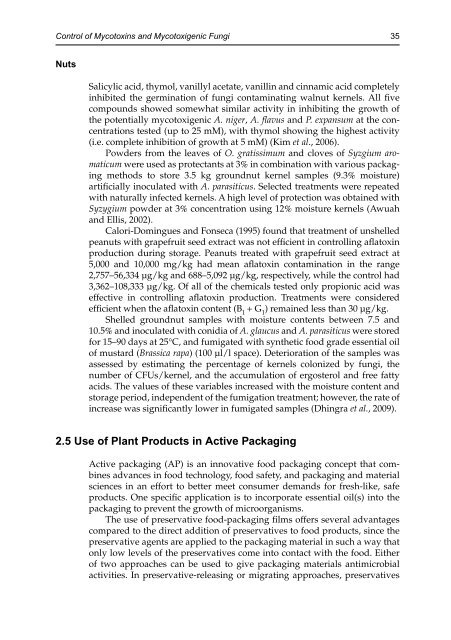natural-products-in-plant-pest-management
natural-products-in-plant-pest-management
natural-products-in-plant-pest-management
You also want an ePaper? Increase the reach of your titles
YUMPU automatically turns print PDFs into web optimized ePapers that Google loves.
Control of Mycotox<strong>in</strong>s and Mycotoxigenic Fungi 35NutsSalicylic acid, thymol, vanillyl acetate, vanill<strong>in</strong> and c<strong>in</strong>namic acid completely<strong>in</strong>hibited the germ<strong>in</strong>ation of fungi contam<strong>in</strong>at<strong>in</strong>g walnut kernels. All fivecompounds showed somewhat similar activity <strong>in</strong> <strong>in</strong>hibit<strong>in</strong>g the growth ofthe potentially mycotoxigenic A. niger, A. flavus and P. expansum at the concentrationstested (up to 25 mM), with thymol show<strong>in</strong>g the highest activity(i.e. complete <strong>in</strong>hibition of growth at 5 mM) (Kim et al., 2006).Powders from the leaves of O. gratissimum and cloves of Syzgium aromaticumwere used as protectants at 3% <strong>in</strong> comb<strong>in</strong>ation with various packag<strong>in</strong>gmethods to store 3.5 kg groundnut kernel samples (9.3% moisture)artificially <strong>in</strong>oculated with A. parasiticus. Selected treatments were repeatedwith <strong>natural</strong>ly <strong>in</strong>fected kernels. A high level of protection was obta<strong>in</strong>ed withSyzygium powder at 3% concentration us<strong>in</strong>g 12% moisture kernels (Awuahand Ellis, 2002).Calori-Dom<strong>in</strong>gues and Fonseca (1995) found that treatment of unshelledpeanuts with grapefruit seed extract was not efficient <strong>in</strong> controll<strong>in</strong>g aflatox<strong>in</strong>production dur<strong>in</strong>g storage. Peanuts treated with grapefruit seed extract at5,000 and 10,000 mg/kg had mean aflatox<strong>in</strong> contam<strong>in</strong>ation <strong>in</strong> the range2,757–56,334 μg/kg and 688–5,092 μg/kg, respectively, while the control had3,362–108,333 μg/kg. Of all of the chemicals tested only propionic acid waseffective <strong>in</strong> controll<strong>in</strong>g aflatox<strong>in</strong> production. Treatments were consideredefficient when the aflatox<strong>in</strong> content (B 1+ G 1) rema<strong>in</strong>ed less than 30 μg/kg.Shelled groundnut samples with moisture contents between 7.5 and10.5% and <strong>in</strong>oculated with conidia of A. glaucus and A. parasiticus were storedfor 15–90 days at 25°C, and fumigated with synthetic food grade essential oilof mustard (Brassica rapa) (100 μl/l space). Deterioration of the samples wasassessed by estimat<strong>in</strong>g the percentage of kernels colonized by fungi, thenumber of CFUs/kernel, and the accumulation of ergosterol and free fattyacids. The values of these variables <strong>in</strong>creased with the moisture content andstorage period, <strong>in</strong>dependent of the fumigation treatment; however, the rate of<strong>in</strong>crease was significantly lower <strong>in</strong> fumigated samples (Dh<strong>in</strong>gra et al., 2009).2.5 Use of Plant Products <strong>in</strong> Active Packag<strong>in</strong>gActive packag<strong>in</strong>g (AP) is an <strong>in</strong>novative food packag<strong>in</strong>g concept that comb<strong>in</strong>esadvances <strong>in</strong> food technology, food safety, and packag<strong>in</strong>g and materialsciences <strong>in</strong> an effort to better meet consumer demands for fresh-like, safe<strong>products</strong>. One specific application is to <strong>in</strong>corporate essential oil(s) <strong>in</strong>to thepackag<strong>in</strong>g to prevent the growth of microorganisms.The use of preservative food-packag<strong>in</strong>g films offers several advantagescompared to the direct addition of preservatives to food <strong>products</strong>, s<strong>in</strong>ce thepreservative agents are applied to the packag<strong>in</strong>g material <strong>in</strong> such a way thatonly low levels of the preservatives come <strong>in</strong>to contact with the food. Eitherof two approaches can be used to give packag<strong>in</strong>g materials antimicrobialactivities. In preservative-releas<strong>in</strong>g or migrat<strong>in</strong>g approaches, preservatives


